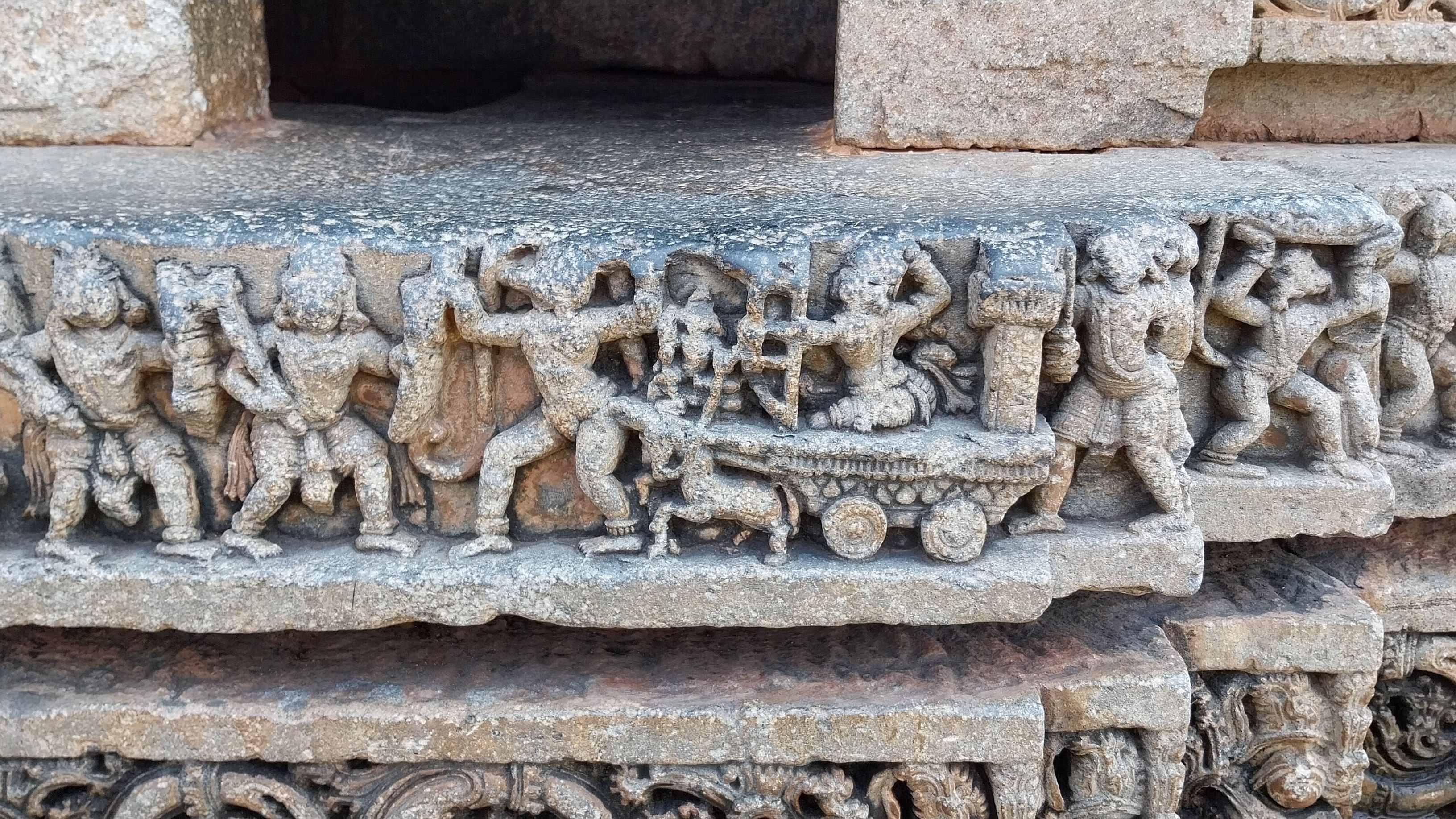
Carvings featured on the walls of the Lakshminarayana temple in Hosaholalu, which depict scenes from various mythological tales.
Credit: Shanthala V
Narrating stories has been an important part of most cultures in many unique ways. Literature is one such significant format of narration. So also, music and dance in classical, folk and many other forms tell stories. Temples in India built through various eras of history provide a unique insight into contemporary times. They do so primarily through the narration of stories from mythology in the form of sculpture, relief art and paintings.
The Lakshminarayana temple in Hosaholalu, 55 km from Mysuru, is an example, where excellent storytelling can be observed. The temple is unique for its outstanding architecture built in the Hoysala style. All features of a typical Hoysala temple are visible here, including the star-shaped plan, the raised platform or the jagati, and the rich, ornate carvings. It is a trikuta temple with three garbhagrihas and a single tower.
The idol of Lakshminarayana in the centre is flanked by idols of Yoganarasimha and Venugopalaswamy on either side. The carvings in soapstone are extraordinary, and can be found on both the external and internal walls of the temple. The craftsmanship shows mastery of geometry, attention to detail, perfection and a refined sense of proportion and scale.
As one moves along the circumambulation path on the jagati, which is outside the temple, one sees ornamentation in stone on the external wall in three sections. This includes the lower horizontal bands (typical of any Hoysala temple), and two levels of exquisite sculptures differentiated by projecting eaves.
Diverse patterns
The richly sculpted horizontal bands wrap around the temple and can be differentiated into six stages. The uppermost displays the Hamsa, below which is the Makara, which are seen in many other Hoysala temples. The third band is where one can find stories from the Ramayana, Mahabharata and the Bhagavata Purana depicted. Floral motifs, a series of horses and a line of elephants occupy the fourth, fifth and the sixth bands respectively.
Each band is separated from the other with deep projections, reminiscent of the stellar external profile of the temple. The strong shadows created by the projections reinforce the segregation between the bands and create a rhythmic progression.
The third band, which is approximately 10 inches in height, is embedded with stories. This is what keeps the visitor engaged to look around the temple, though the larger iconography in the upper levels also draws attention.
The stories are very well-narrated, with the multiple frames sculpted to detail. The representation of sequence in the story and the progression to the next event is very innovatively managed by creating pauses, changing the orientation of the characters and staggering the wall planes.
The imagination and representation of covered and enclosed spaces in the stories deserves special mention. For instance, the forest described in the Ramayana, where Rama was in exile, comes alive through a series of carvings of trees, interspersed with wildlife. The story of Prahalada is carved through the sequences of tests that his father put him through.
The staggered walls of the star-shaped exterior have also come in handy to segregate themes and sequences. Clarity has been maintained in the sequence of events.
The fire of Dasharatha’s yagna and the ocean in the Ramayana are represented beautifully in these soapstone sculptures too. The scenes from the war, both from the Ramayana and Mahabharata are vivid, with the different types of rathas, weapons and the symbolic representation of the chakravyuha (a military formation). Bheeshma’s shara shayya (the bed of arrows) has been carved, showing the precarious way in which the body of Bheeshma was supported by arrows, surrounded by the conditions of the battlefield.
Other scenes of the Samudra Manthana and Krishna’s childhood not only challenge us to remember the stories but also help us recall the nuances within them. The temple thus upholds the outstanding craft of storytelling in stone. The carvings represent a minimalist way of presenting the large epics of our cultural heritage.